BACK
TO
WEATHER-BLOG
MENU
New!
Fine
Art
Prints
&
digital
images
for
sale-
Welsh Weather
& Dyfi Valley landscapes Slide-Library - Click HERE
Note: a version of this
post for people less familiar with geology can be found HERE.
| "The
climate
has
always
been
changing",
or
words
to
that effect. How many
times have you read that little gem of wisdom in online discussions or
Tabloid op-eds? It usually means that the author of the comment has run
out of other arguments with which to attempt to rubbish climate
science.
So what's the answer? Sure it has! The rocks in my local patch - Mid-Wales - span a time, over 440 million years ago, when a remarkable period of climate change occurred - and they record its passing. However, before anyone gets excited, I should add an afternote. The change was accompanied by the second biggest mass-extinction in the Phanerozoic (last 542 million years) fossil record. Mr Tabloid Writer might like to pause to reflect upon that for a moment. In the meantime, I'll set the scene. The rolling hills of the Cambrian Mountains, around the Nant-y-moch hydro-electric reservoir, are the old stamping-ground for all former students from the Geology Department at Aberystwyth University, myself included. The quarried ridge of Carn Owen - circled in the map below - is where countless Aber geology undergrads first learned the art of geological mapping. It lends itself admirably to the purpose - there's lots to see in less than a square kilometre.... 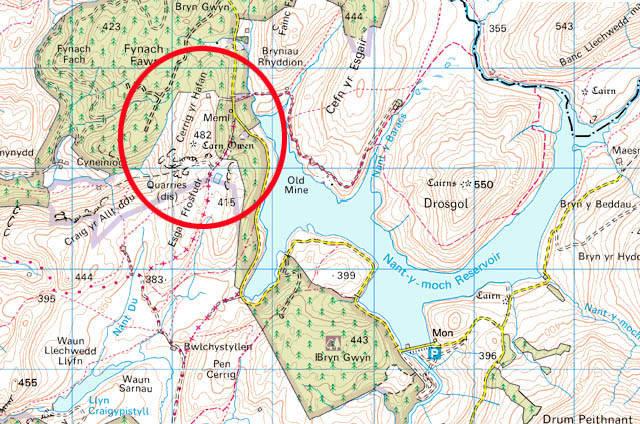 Image credit: Ordnance Survey, from the excellent Ordnance Survey Get-a-map service. Here's a quick look at the Phanerozoic timescale - the past 542 million years - for context:  I've abbreviated the Period names for the sake of space. The relevant ones here are: ORD = Ordovician Period, 488.3-443.7 and SIL = Silurian Period, 443.7-416 million years ago. With that in mind, let's have a look around.... The first thing that catches the eye on arrival at Carn Owen is the big main quarry, with faces tens of metres high, that was last worked in the 1950s when the Nant-y-moch dam was under construction.... 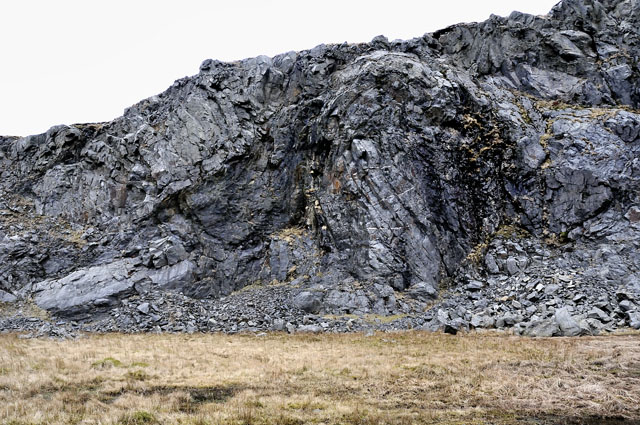 The quarrymen who worked in this windswept spot exploited hard sandstones that belong to the Drosgol Formation, of late Ordovician age (see reference 4 for full local geology). Around to the left, a short steep ascent over grass, mosses and cropped bilberry leads to the summit, with its ancient ring-cairn, made of sandstone blocks:  Wherever this hard sandstone is to be found outcropping hereabouts, our forebears - the Bronze-Age people - marked summits with large cairns. Cairn-building, still popular today, clearly goes back a long time - though I suspect there was a more significant purpose to the exercise back then! From the summit of Carn Owen, the ridge of Cerrig yr Hafan extends for a kilometre northwards. Before it plunges into the forestry. the remains of the Setts Quarry, a 19th Century venture that also worked those hard Drosgol Formation sandstones, are reached: 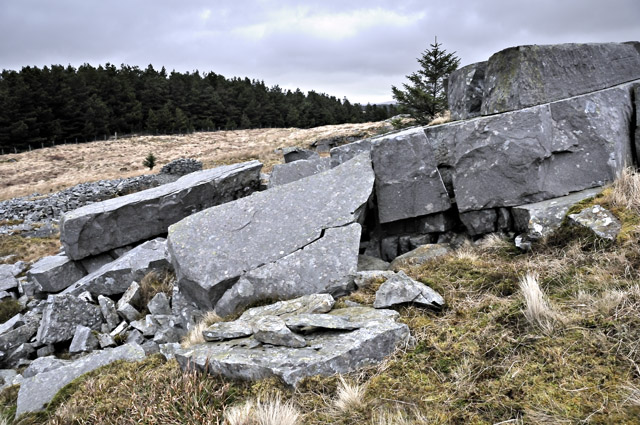 From Setts Quarry, an old tramway runs back southwards along the hill's eastern flank, ending above two smaller quarries, separated by a spoil-bank. Here's the western quarry face. The rocks can be seen to be well-layered, and the layers are all tilted at the same angle to the right (eastwards). The tilting is due to the strata being situated on the east flank of an anticlinal fold - an arch-shaped structure, with the oldest rocks in the middle and progressively younger rocks outcropping on either side outwards. 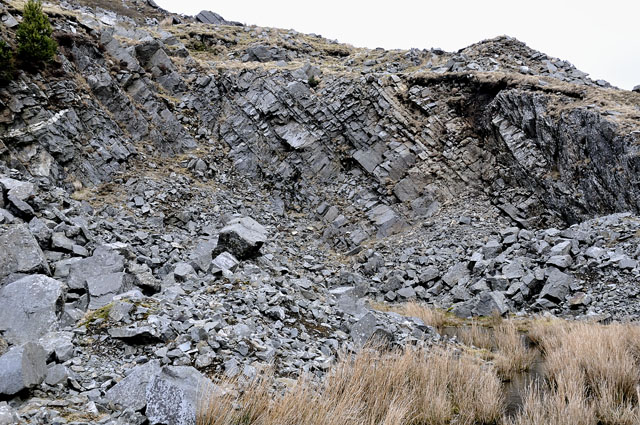 The rocks in the western quarry all belong to the latest Ordovician, specifically the Hirnantian Stage, covering a brief (geologically-speaking) timespan from approximately 445.6 to 443.7 million years ago - less than a couple of million years. They were deposited in the marine sedimentary basin that occupied much of what is today known as Wales during the Lower Palaeozoic era. The well-layered rocks in the image - again hard sandstones - are the upper part of the Drosgol Formation. To the right of the image, relatively structureless grey rocks are present: these belong to the overlying Bryn-glas Formation. Let's have a closer look. This is what the Drosgol Formation's sandstone looks like up close. Full of grains of quartz and feldspar, it is pale, hard and splintery. In some other places in the district, it also contains beds of rounded quartz pebbles. Now, in order to transport such coarse-grained sediments to their place of deposition, the environment needs to be one of relatively high energy, with strong currents at work - a place of great turbulence.  This is the eastern quarry face. Here, we are further up in the sequence - in slightly younger rocks in other words. The grey rather solid-looking rocks that make up the left-hand part of the exposure belong to the top of the Bryn-glas Formation, but near the middle a marked change occurs and they are overlain by rather flaky, rusty-coloured rocks. The change marks the position of the Ordovician-Silurian boundary, 443.7 million years ago. The rusty-coloured flaky rocks of the lowermost Silurian are termed the Cwmere Formation. 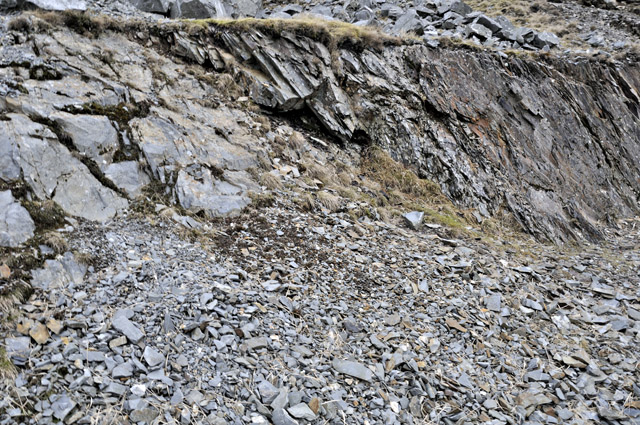 Here is a close-up of the Bryn-glas Formation - it consists of rather monotonous massive grey silty mudstone....  ...whilst here is the overlying Cwmere Formation from the Lower Silurian. It consists primarily of dark grey mudstone which weathers to a rusty colour. The rusty weathering is due to the common pyrite - iron sulphide - that the formation contains. The technical name for this rock is "hemipelagite" - meaning deep sea mud.  Unlike the high-energy sandstones of the Drosgol Formation and the massive mudstones of the Bryn-glas Formation, the Cwmere Formation contains lots of fossils. This alone suggests it was deposited in a low-energy environment - strong currents charged with sediment would tend to smash fragile animal remains to bits. The commonest fossils to be found in the Cwmere Formation are graptolites (below). This specimen, with individuals 4-5cm in length, was collected some years ago from a block of unweathered mudstone, from the tip of a nearby lead-mine. The graptolites are beautifully preserved by the pyrite that has replaced their organic structure. Graptolites were free-floating organisms that existed, like modern plankton, close to the sea surface. Because of that mode of existence, they were transported widely around on the currents of the ancient seas. Thus, wherever fossiliferous Lower Silurian mudstones of marine origin are found around the world, they are likely to contain graptolites just like these. The other important thing about graptolites is that they evolved rapidly: appearing in the Cambrian Period, they underwent such rapid explosions of evolution during the Ordovician and Silurian that these two periods have been divided into graptolite biozones - a rock's graptolite fauna can tell the geologist which stage of which period it belongs to. Useful! 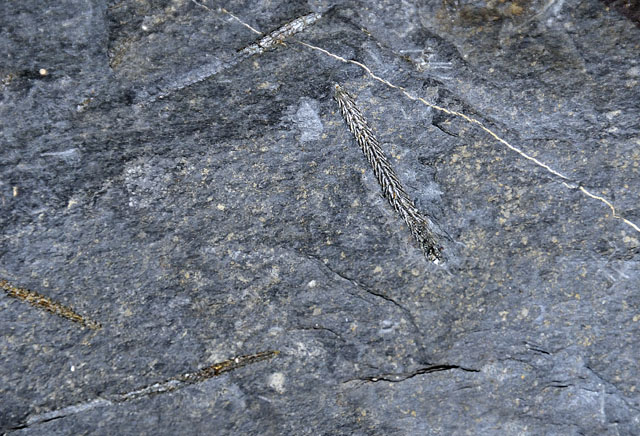 More rarely, orthocones are found in the Cwmere Formation. The one illustrated below is an especially fine example: about 7cm long, it is preserved in 3D by pyrite. Orthocones were cephalopods - ancient ancestors of the modern-day Nautilus - swimming freely throughout the seas. 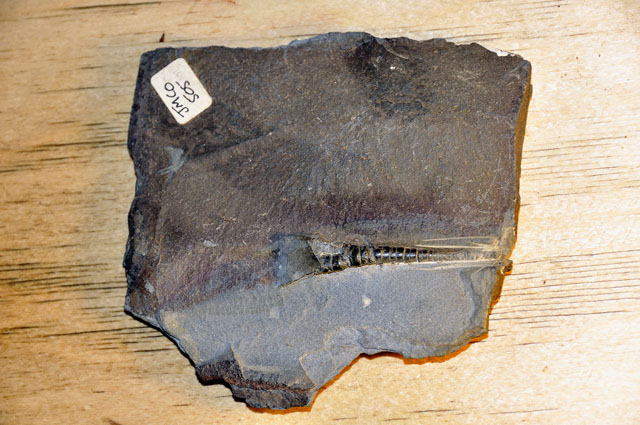 Finally, going to a microscopic scale, there are pyrite framboids throughout the Cwmere Formation. The image below was taken down a reflected light microscope, looking at the surface of a chip of Cwmere Formation mudstone that has been polished to an optical finish. In the image, the largest framboids - the bright-coloured spheres - are less than a millimetre across. What are framboids? Some think they formed by an entirely chemical process within the sediment: others have suggested that they represent clumps of mineralised fossil bacteria. Either way, they record the fact that the chemical environment on the sea-bed where the Cwmere Formation was deposited was a strongly reducing one i.e. free oxygen was scarce or absent and the substrate would have been stinking, sulphurous black mud.  So, in a sequence exposed across a short distance on this mid-Wales hillside, we have seen a transition over less than a couple of million years from high-energy, turbulent conditions to a stagnant, deoxygenated undersea plain where fine, muddy sediment only accumulated slowly and animal remains were preserved in pyrite. What happened? First, we need some context. Palaeogeographical reconstructions of the Earth show how the continents have drifted around, collided and split up over the past hundreds of millions of years. The globe below is a reconstruction of how things would have looked at the end of the Ordovician Period, when the rocks of Carn Owen were being deposited. England, Wales and southern Ireland were part of a block of continental crust known as Avalonia, and to its north lay the Iapetus Ocean, separating Avalonia from Laurentia, which included Scotland and the north of Ireland. Avalonia lay at a low latitude in the Southern Hemisphere and the South Pole was straddled by the large continent of Gondwana. 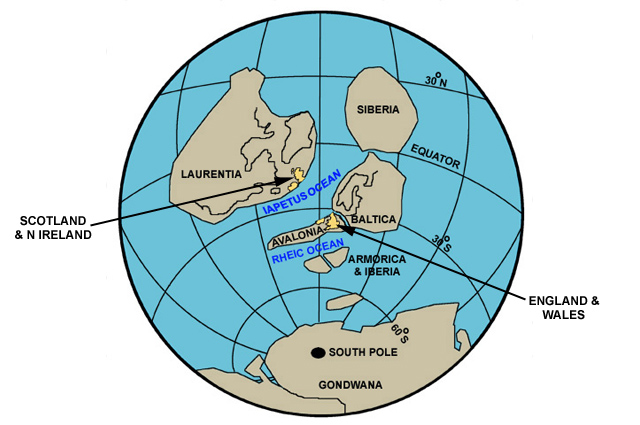 Zooming in, this is what the area that is now England and Wales would have looked like at the time of the deposition of the Cwmere Formation. Such maps can be created by studying the rocks: their composition and fossil fauna and/or flora tell us about the environmental conditions, such as sea-depth, at the time. In the early Silurian, the Carn Owen area, just to the north-east of where Aberystwyth is now situated, lay in a deep marine basin on the southern margin of the Iapetus Ocean. Across to the east, the area that is now the Midlands was a low-lying landmass that was partially submerged under a shallow "shelf" sea. 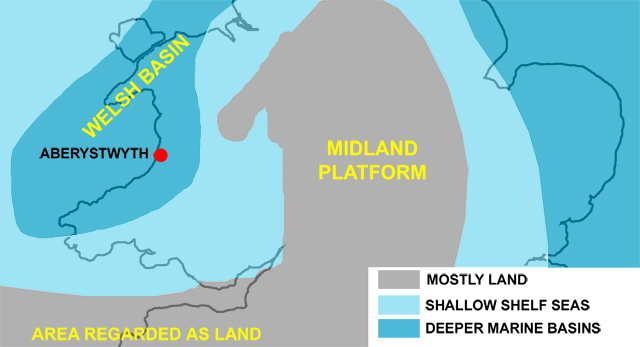 However, during the preceding Hirnantian, the map would have looked a bit different: 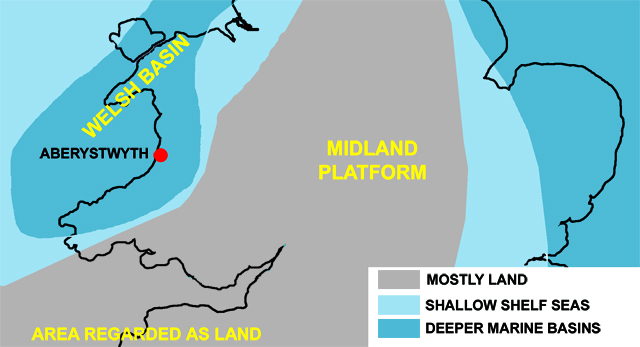 Prior to the Hirnantian, extensive shelf-seas with an abundant bottom-dwelling fauna (indicating decent oxygen levels) covered much of East Wales, Shropshire and Herefordshire. Then, during the Hirnantian, sea-levels fell drastically (it has been estimated that a fall of at least 80m was involved - reference 3). Less than two million years later, at the beginning of the Silurian, the shelf-seas returned again, flooding in over the Midland Platform. This sudden (in geological terms) retreat and readvance of the sea had profound effects. For a start, the retreat caused extensive areas of shallow shelf sea, teeming with life, to become dry land. That was one factor in the great mass-extinction that accompanied the changes - loss of habitat. The land at the time was not densely-vegetated like that of today: the first primitive land-plants only appeared during the Ordovician and it was only later in the Silurian that they really got going. As a consequence, with nothing much holding the ground together, sediment was readily eroded from the newly-emerged land by rainfall and rivers alike, transported to the edge of the Welsh Basin and trundled down into its depths by powerful submarine debris-flows, covering the basin floor with mud, silt, abundant coarse sand and, in places, pebbles. Thus were the Drosgol and Bryn-glas Formations deposited. When sea-levels rose again, flooding back over the shelf, erosion of sediments by rainfall and rivers was curtailed and the Welsh Basin became relatively isolated from the sediment source, so that only the finest muds settled out over its depths, onto which the remains of the graptolites and orthocones settled out from the near-surface waters high above. In this way, the Cwmere Formation came into being. So what caused this sudden double-flip in sea-levels? We have to look at the rocks that were deposited over the great southern continent, Gondwana. ICE-IN THE SAHARA? - GONDWANA AND THE HIRNANTIAN GLACIATION: CAUSES Gondwana has long since split up into fragments. Bits of it now constitute Africa, South America, India, Antarctica and Australia. In several of these modern continents, late Ordovician rocks occur that have features that can only have had one origin - from glaciers and ice-caps. Such direct indicators of ancient glaciation that are preserved in the geological record include things like striated rock surfaces - ice-sheets full of rocky debris do a good job of grinding down the rocks underneath. The striking image below shows an example: it illustrates a glacially-striated rock surface in Jebel Eghei, in the Libyan Sahara Desert (photo reproduced with thanks to Seb Luning). 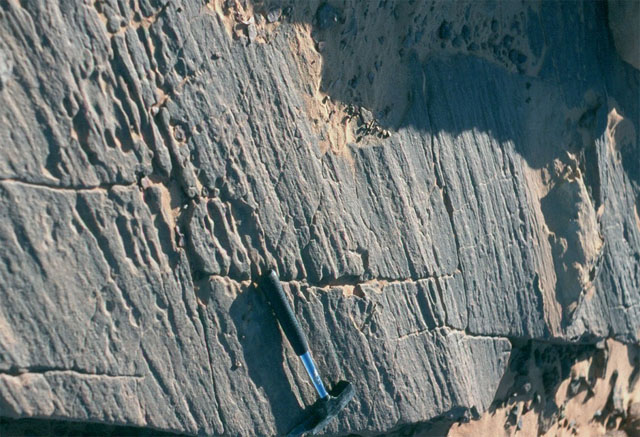 There are also indirect indicators of ancient glaciation: the fall (and subsequent rise) in sea-levels, recorded on Carn Owen by those changes in rock-types described above, is to be found in marine rocks of the same age all over the world - therefore the sea-level changes were eustatic - global - in nature. In other words, there was a global cooling, leading to a major ice-age, with attendant global sea-level falls due to so much water being locked up in ice, followed by a global warming, melting the ice and bringing worldwide sea-levels back to "normal" again (reference 1). How, then, did it happen? For a global cooling sufficient to generate conditions that favour glaciations to occur, as indeed also occurred during the late Cenozoic era - the run-up to the most recent ice-ages - there are several variable drivers of global climate that act on the required timescale. The geographical arrangement of the continents due to plate tectonics affects prevailing atmospheric and ocean currents. The composition of the atmosphere affects its ability to lose heat (infra-red radiation) to space or retain it. The energy output from the sun affects the amount of visible and ultra-violet radiation reaching Earth. Taking geography first, having the continent of Gondwana over the South Pole would be advantageous if you want ice-caps to start forming: it would have played a role similar to that of Antarctica today. So that's one box ticked. 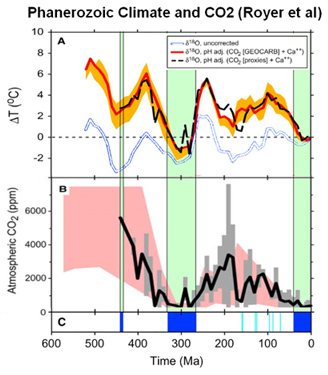 As to
atmospheric composition, it appears that carbon dioxide levels
during the Ordovician were much higher than present atmospheric levels,
running at several thousand parts per million (ppm). Palaeotemperature
data suggest that, through
much
of
the
Ordovician,
Earth
had
a
stable
Hothouse-type
climate
similar to that during the late Mesozoic and the early Cenozoic.
It seems that a fairly stable carbon-cycle
existed, with a balance between sources such as volcanic outgassing and
sinks such as ocean uptake. As to
atmospheric composition, it appears that carbon dioxide levels
during the Ordovician were much higher than present atmospheric levels,
running at several thousand parts per million (ppm). Palaeotemperature
data suggest that, through
much
of
the
Ordovician,
Earth
had
a
stable
Hothouse-type
climate
similar to that during the late Mesozoic and the early Cenozoic.
It seems that a fairly stable carbon-cycle
existed, with a balance between sources such as volcanic outgassing and
sinks such as ocean uptake.However, in the late Ordovician, this relative stability seems to have been disturbed. Major episodes of mountain-building and volcanic activity occurred only a few million years prior to the Hirnantian glaciation, such as the Taconic Orogeny, which affected what is now eastern North America. When mountain-building occurs, erosion increases by orders of magnitude as the newly-uplifted ranges develop drainage-systems: the erosion massively increases the surface area of material available to weathering agents like rain - carrying dissolved carbon dioxide - and other substances. Weathering of rocks is thus a major carbon-sink, so that any mountain-building episode has the potential to create a significant new carbon dioxide drawdown. Geochemical models track fluxes of carbon entering and exiting the atmosphere. One such well-regarded model, which predicts carbon dioxide levels for the entire Phanerozoic, is GEOCARB, with a time-step of 10 million years (reference 2). However, this is too coarse a resolution to pick up any shortlived major dip in carbon dioxide levels around the geologically brief cold period of the Hirnantian (reference 6). Can we find good evidence of enhanced carbon dioxide drawdown at this time, via other methods? 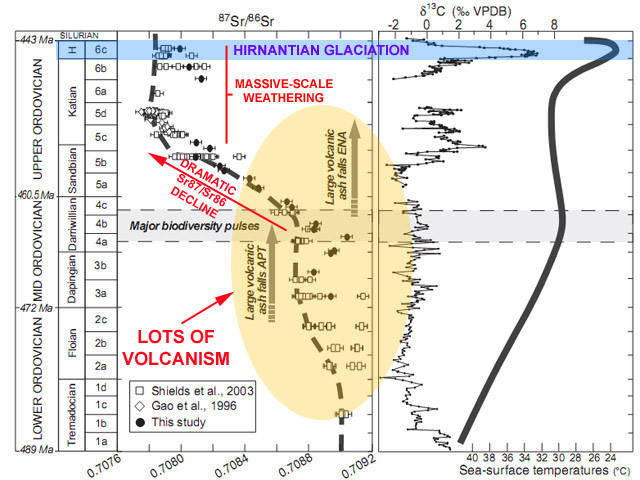 It appears so. Recent research (diagram above - with my colour annotations - from reference 9) has looked at the ratios of strontium isotopes in post-Taconic (late Ordovician) limestones in North America. The later Ordovician limestones showed a dramatic Sr87/Sr86 ratio decline to much lower values (LH plot, above): indeed, the paper's abstract says: "A large drop in seawater 87Sr/86Sr during the Middle Ordovician was among the most rapid in the entire Phanerozoic." The research indicated that this trend could well be due to the onset of massive-scale weathering of basalts - igneous rocks enriched in strontium-86. Basalts consist mainly of various silicates of calcium, sodium, magnesium and iron, all of which readily react with carbon dioxide dissolved in rainwater, the resultant solutions reprecipitating the calcium and carbonate ions as limestone. In addition to the effect of this carbon-sink, the widespread volcanism of the Middle Ordovician was on the wane, reducing carbon dioxide outgassing. More specifically, the abstract of Reference 9 goes on to state: "A close balance between volcanic outgassing and CO2 consumption from weathering produced steady pCO2 levels and climate through the middle Katian, consistent with recent Ordovician paleotemperature estimates. In the late Katian, outgassing was reduced while volcanic weathering continued, and resulted in a cooling episode leading into the well-known end-Ordovician glaciation." So yes, it appears that carbon dioxide levels did drop quite sharply for a time in the late Ordovician: indeed, it has been estimated that they fell from 5000ppm to 3000ppm or less (reference 6) as a consequence of the events described. 3000ppm of carbon dioxide still sounds high, but before jumping to conclusions popular elsewhere in the blogosphere, we still have another main driver to take into account. What about the Sun? Established nuclear models of main sequence stars indicate that it would have been 4-5% dimmer than it is today (references 5,6). Solar radiance is thought to have increased in a pretty much linear fashion by about 10% per billion years of Earth's history and the following graph charts this increase through the Phanerozoic:  What difference would 4-5% less incoming solar energy make? Global climate models, calibrated to today's conditions, predict that permanent ice can start to develop when carbon dioxide levels drop below 500 ppm (i.e. if all of Earth's icecaps melted in the future due to global warming caused by very high, say 800ppm, carbon dioxide levels, they would eventually start to reform if those levels again fell below the 500 ppm mark). Calibrating the models to the mid-Cenozoic gives a range for this "ice threshold" of 560–1120 ppm carbon dioxide, and as Royer (reference 6) notes, global climate models and energy balance models calibrated to Late Ordovician conditions, with 4-5% less solar irradience, predict an ice threshold of between 2240 and 3920 ppm carbon dioxide. So: combine a dimmer sun, a sudden drop in carbon dioxide levels to within the ice-threshold area and a large continent over the South Pole and that appears to have been sufficient to get the temperature low enough to allow glaciation to develop, as the consequence of several key climate drivers working in conjunction with one another. Was there an alternation of glacials and interglacials, as in the recent Pleistocene events? It appears so: deposits in what was North Gondwana record two well-defined ice-related depositional sequences separated by major erosional unconformities (reference 1). The Milankovitch (orbital) forcings were not necessarily just restricted to the last Ice Age's sequence of alternately advancing and retreating ice-sheets. How did temperatures and carbon dioxide levels bounce back into the early Silurian? This remains problematic (reference 1): weathering of carbonate sediments on the uncovered shelf-sea areas in the relative absence of calcifying plankton (i.e. mass-extinction had partially disabled an important carbon-sink) may have been one reason; strongly reduced silicate weathering-rates in glaciated areas has also been suggested: either would increase atmospheric carbon dioxide levels again. Like many such things of the dim and distant past, there remains plenty of scope for worthwhile research! THE LATE ORDOVICIAN MASS-EXTINCTION According to the fossil record, during the late Ordovician glaciation, 26% of all families and 60% of all genera of both terrestrial and marine life worldwide were exterminated (reference 8). It was the second-biggest such event in the fossil record - the huge end-Permian extinction being the most spectacular, as the sketch-graph below shows.  We know that the extinction accompanied a period of rapid climate change that followed, and was followed by, periods of high mean global temperatures. The extinction took place over a couple of million years - as opposed to relatively sudden disaster-movie events like the K-T boundary extinction: indeed, it appears to reflect a prolonged period of environmental stresses, including the aforementioned major fluctuations in sea level associated with glaciation and accompanying changes to ocean temperatures and chemistry. Oceanic changes are particularly implicated in the loss of coral-reefs: although some individual species of corals survived, living reefs themselves disappeared from the face of the Earth. Although the mass-extinction was followed by a Lower Silurian biodiversity "explosion", it took as much as 6 million years for coral reefs to reappear, making the episode the first true ‘reef gap’ in the geological record. The detailed explanation for these stresses is outside the scope of this post (see references 7 and 8 for further reading) and is indeed a subject of ongoing research. However, the important point should be made that any major and geologically rapid climate shift in either direction - warmer or cooler - from a stable state brings with it drastic environmental changes that can have profound effects on ecosystems and create the potential for extinction-level events. It should also be pointed out that our burning of the fossil fuels on such a massive scale over just a couple of centuries puts the current environmental and atmospheric changes up there with the bigger examples of the past. It's surprising what the geology of a couple of small, grey crags on a Mid-Wales hillside can lead one into. Interestingly, across the Nant-y-Moch reservoir, on the shoulder of the hill called Drosgol (after which the Formation was named), there is evidence of another period of Earth's climate, where rocks and minerals along a fault-line show evidence of such pervasive, penetrating chemical weathering that they likely record another bygone age. This time, they point to the Cenozoic era, when Wales had a tropical climate, before the long-term cooling that led to the more recent glaciations that shaped the modern Welsh landscape. Something for another post, possibly: another excuse for an afternoon tramping these hills, with their hidden geological surprises! REFERENCES: Internet: Geological Timescale - Subcommission for Stratigraphic Information Publications (Google for PDFs in most cases): 1) Armstrong, H.A. (2007): On the cause of the Ordovician glaciation. In: Williams, M., Haywood, A.M., Gregory, J. and Schmidt, D.N. (eds): Deep-time perspectives on climate change: marrying the signal from computer models and biological proxies, 101-123. Published by the Geological Society for the Micropalaeontological Society. ISBN: 1-86239-240-4. 2) Berner, R.A. and Kothavala, Z. (2001): GEOCARB III: a revised model of atmospheric CO2 over Phanerozoic time. 3) Brenchley, P.J., Marshall, J.B, Harper, D.T., Buttler, C.J. and Underwood, C.J. (2006): A late Ordovician (Hirnantian) karstic surface in a submarine channel, recording glacio-eustatic sea-level changes: Meifod, central Wales. Geological Journal 41: 1–22. 4) Cave, R. and Hains, B.A. (1986): Geology of the country between Aberystwyth and Machynlleth . Memoir of the British Geological Survey, Sheet 163 (England and Wales). 5) Minton, D.A. and Malhotra, R. (2007): Assessing the massive young sun hypothesis to solve the warm young earth puzzle. The Astrophysical Journal, 660: 1700-1706. 6) Royer, D.L. (2006): CO2-forced climate thresholds during the Phanerozoic. Geochimica et Cosmochimica Acta 70, 5665–5675. 7) Sandberg, P.A. (1983): An oscillating trend in Phanerozoic non-skeletal carbonate mineralogy. Nature 305: 19–22. 8) Veron, J.E.N. (2008): Mass extinctions and ocean acidification: biological constraints on geological dilemmas. Coral Reefs 27, 459–472. 9) Young, S.A., Saltzman, M.R., Foland, K.A., Linder, J.S. and Kump, L.R. (2009): A major drop in seawater 87Sr/86Sr during the Middle Ordovician (Darriwilian): Links to volcanism and climate? Geology, October 2009, v. 37, p. 951-954. |
|
BACK TO WEATHER-BLOG MENU New! Fine Art Prints & digital images for sale- Welsh Weather & Dyfi Valley landscapes Slide-Library - Click HERE |